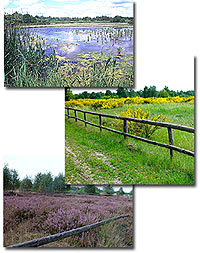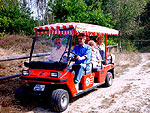












The Döberitzer Heide is situated with 3.871 hectare inside the community Dallgow-Döberitz and encompasses two thirds of the community area. It is one of the prettiest and richest in species nature reserves around Berlin. Apart from its function as fresh air aisle for the metropolis Berlin the Döberitzer Heide is known for its special nature abundance.
This abundance is actually unintentional due to the military, who confiscated the Heide over centuries and developed into a military training area. The result was that urban sprawl of the areas and fragmentation into agricultural used fields never happened.
So the Heide is today one of the largest cohesive open space area in Berlin's surrounding area. Its appeal consists of a diversity of adjacent situated biotopes. Part of this are dry grassland, heather, moors, alder and moor forests, bushes and water bodies. Numerous rare native animals and plants could be preserved.
With hoopoe, tawny pipit, wheatear, barred warbler, woodlark, whinchat and European nightjar territories the area has nationwide importance. Worth mentioning is the existence of Eurasian hobby, common snipe, bearded reedling or cranes. Until now there is proof of ca 150 bird species among them 124breeding birds.
The Döberitzer Heide is mostly located in the district Havelland only a small southern tip is in the district of Potsdam-Mittelmark. The surrounding communities are Elstal, Dallgow-Döberitz, Seeburg, Groß-Glienicke, Krampnitz, Kartzow and Priort.
The Döberitzer Heide offers a mosaic of different biotopes with open space areas, succession areas and non-agricultural forest types. One finds smaller bogs and water bodies as well as other wetlands, which brings considerable structural diversity. Dry oak-birch-forest, heath lands alternate with the reeds of the smaller water bodies. The forest takes roughly half of the area But there are no old high forests. Next to individual trees, who are older than 100 years, a forty to eighty year old mixed woodland consisting of birches and oaks, robinias, lime trees, elms and pines prevails. Over fifty different tree species were counted. Around 560 species of fern and blooming plants exist. Many of them are endangered and are on the red list as for example the meadow pasque flower, white cinquefoil, spider plants and cotton grass.

In May 1999 the first 12,4 kilometre long section of the hiking path through the Döberitzer Heide was opened to the public. A year later, in May 2000, the second section of the hiking path, which is remarkable 9,3 kilometres long was opened.
To the three existing entrances two new ones were added, via the Artilleriepaik and via the housing estate Sperlingshof. Clear sign-posts at the entrance areas and along the paths point to dangers if you leave the intended route.
Excursions and guided tours with professional explanations through the Döberitzer Heide are being arranged by the Naturschutz-Förderverein.
Naturschutz-Förderverein Döberitzer Heide e.V.
Naturschutzzentrum 1
14627 Elstal
Tel.: 033234 - 70 80
Fax: 033234 - 70 83 0
Internet: www.la21-doeberitzer-heide.de